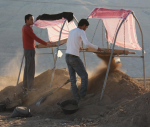You are here
Jordan’s mitigation policies curbed inflation rates in 2022 — World Bank Group
By Mays Ibrahim Mustafa - Apr 11,2023 - Last updated at Apr 11,2023

Unlike many other countries in the MENA region, Jordan managed to maintain a ‘relatively low’ level of inflation in 2022 due to its mitigation policies, according to a report by the World Bank Group (Photo by Amjad Ghsoun)
AMMAN — Inflation levels in Jordan remained relatively unaffected by the global increase in food prices caused by the start of the Ukraine war in February 2022, due to a series of mitigation efforts implemented by the Kingdom, according to a recent report from the World Bank Group.
The report was published in April 2023 under the title “Altered Destinies: The Long-Term Effects of Rising Prices and Food Insecurity in the Middle East and North Africa [MENA]”.
The report mainly argues that “even if the spike in inflation, particularly food-price inflation, turns out to be short-lived, it will still result in long-term development challenges that should, in principle, alter public policy priorities in the short- and long-term”.
Unlike many other countries in the MENA region, Jordan managed to maintain a “relatively low” level of inflation in 2022 due to its mitigation policies, despite the increases in the international prices of commodities that pushed inflation rates higher in the rest of the region, according to the report.
Inflation-mitigating policies that were deployed in Jordan after the start of the Ukraine war include imposing new food and energy price controls, loosening import restrictions on specific products, increasing food and fuel subsidies and implementing indirect tax exemptions, the report said.
Commenting on the report’s findings, Economist Hosam Ayesh agreed that last year’s inflation rates were curbed in Jordan due to certain government measures, such as restructuring customs fees and reducing the sales tax on some commodities and products.
However, there are other factors that need to be investigated to arrive at a more comprehensive understanding of the situation, he told The Jordan Times.
Ayesh claimed that high unemployment levels and receding income levels, leading to a decrease in people’s spending power, which is evidenced in the low demand seen in many sectors, can help ease inflation.
Food insecurity in MENA region
The World Bank Group report indicates a high level of food insecurity in the MENA region, which is projected to increase.
The report estimates the region’s 202 development financing needs for severely food insecure people to be between $27.73 billion to $38.05 billion. In Jordan alone, the report projects a financing need of between $620 million to $850 million.
By 2027, the Kingdom’s financing needs are expected to increase, reaching a projected range of $520 million to $1.05 billion, according to the report.
“Policymakers should address chronic food insecurity before it becomes acute. A mix of short-term and long-term measures may prove effective in addressing food insecurity. But, the origins of food insecurity matter, especially when deciding how best to address short-term needs,” the report stated.
The percentage of severely food insecure people in the region, which stood at 11.8 per cent in 2006, is forecast to reach 17.6 per cent in 2023, according to the report, which also estimates that the rise in food prices will lead to a 17 to 24 per cent increase in the risk of stunted growth in the region due to the lack of proper nutrition in utero or during early childhood.
The report also highlighted disparities in food insecurity levels within developing MENA economies.
“Syria and Yemen are major contributors to the rise in food security in the MENA regional average. Food insecurity in Syria rose from 5.3 per cent in 2005 to a forecast of 50.8 per cent in 2023; in Yemen it rose from 10.1 per cent in 2005 to a forecast of 99 per cent in 2023,” the report stated.
Related Articles
AMMAN — Jordan’s real GDP is expected to grow 2.1 per cent in 2022, and 2.3 in 2023 and 2024, from 2 per cent in 2021, according to th
AMMAN — Food prices in Jordan increased by 1.3 per cent in September, according to the most recent food security update issued by the
AMMAN — Despite an inflation rate of 2.45 per cent for the first eight months of 2023, economists argue that consumers perceive


















